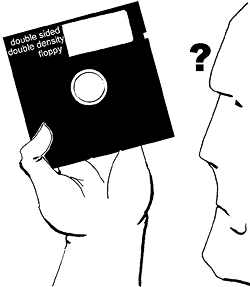![[Metroactive Features]](/features/gifs/feat468.gif)
[ Features Index | San Jose | Metroactive Central | Archives ]
 Illustration by Jeremy Russell Core Memory Computers are dying faster than we are By Annalee Newitz AFTER DRIVING WITH an escort past armed guards, Jesse and I arrived at the Computer Museum History Center at Moffett Field in Mountain View. Despite the high security measures (this was, after all, a former Air Force base), we were still expecting to find a typical museum, with the usual alienating displays: tidy, labeled bits of tech under glass, "hands off" signs, and robotic arms behind velvet ropes. Instead, we found a giant warehouse whose concrete floors were stocked with a huge collection of computing machines, arcane devices and incomprehensible widgets. An unassuming little bundle of wires nestled inside what looked like a coffee table turned out to be the computer which had controlled the Minuteman missile. Something that looked like a 1970s sofa was actually a Cray computer. Next to it, humbly arranged on the floor, was an SGI machine the size of an outdoor barbeque pit. Somebody had put a post-it note on it which read, "This computer works--put in a disk and it boots up!" There was a wall of burned-out wires and vacuum tubes housed in a curved, art deco frame with 6-foot-tall sliding glass doors. It had no label, no discernable function. Like so much of what we saw in the museum, it was a raw, undigested chunk of a historical tradition we've barely begun to chronicle. We joined a group of oddly dressed Germans on a short tour with museum docent Chris Garcia, on whom I immediately developed a mad crush. It's hard for me to watch a sarcastic young man explaining the technical specs on mainframes without getting a little worked up. So sue me. And O the mainframes! We could touch them, open them, wiggle their switches, even taste them if we were techno-kinky enough (note to museum staff: no, I did not actually taste the DEC 10). I had of course seen pictures of VAXes and PDPs. They were usually taken from old 1960s-era textbooks, and often included a handful of male humans wearing black horn-rimmed glasses and white lab coats, whose bodies looked like oddly shaped peripherals for the walls of blinking lights and switches to which they were attached. But standing next to a mainframe spitting punch tape is nothing like seeing them in books. Soon we got to the PC area of the museum, complete with an Apple I, its chip board bolted to a piece of wood. It was surrounded by Xerox Altos (the legendary computers developed in the early '70s at Xerox PARC, which supposedly inspired Steve Jobs to drop acid and dream of GUIs), an Atari 600, a Commodore 64, and an Apple II. These were the computers from my early days as a hacker wannabe, machines on whom I had heaped years of adolescent desires. Although in my memory the Apple II will always look like a Porsche, these crud-colored boxes with their cloudy screens reminded me that the mid-80s are practically medieval now. Although the museum houses hundreds of machines and computer-related ephemera from the past 100 years, very few people actually come to visit. Partly that's a result of the intimidating wall of security one has to endure (this, I am assured, will no longer be the case in a few months). Also, I think, it's because people don't realize how much the history of computing is relevant to understanding the development of our contemporary culture and everyday life. After our tour was over, I imposed on the winsome Chris to tell Jesse and me a little bit more about the machines. We all ended up having a long coversation with museum volunteer Lee Courtney about core memory, the first widely used form of random access memory and forerunner of today's silicon-based memory chips. Lee and Chris showed us some of the earliest core memory, huge poster-sized sheets of wires coiled tightly together in webs where 3 square inches might hold 12 bytes. Then we moved on to drum memory, and finally wandered over to a cylindrical device where memory had once been stored in mercury. As we drove home, I kept thinking about core memory, and how so much of what we do in the "information economy" depends on what grew out of those tiny, electromagnetic wires that not so long ago lit up the faces of mainframes. Now it's up to us to preserve the memories of those machines, and the people who worked on them. For all their seeming invulnerability, computers are dying faster than we are.
Annalee Newitz is a surly media nerd who remembers playing Oregon Trail on the Apple at Deerfield Elementary School in 1978. She's at core@techsploitation.com. [ San Jose | Metroactive Central | Archives ]
|
From the February 8-14, 2001 issue of Metro, Silicon Valley's Weekly Newspaper.
Copyright © 2001 Metro Publishing Inc. Metroactive is affiliated with the Boulevards Network.
For more information about the San Jose/Silicon Valley area, visit sanjose.com.